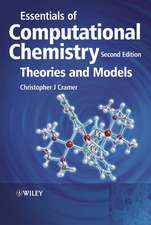Current Distributions and Electrode Shape Changes in Electrochemical Systems: Lecture Notes in Engineering, cartea 75
Autor Johan Deconincken Limba Engleză Paperback – 30 mar 1992
Din seria Lecture Notes in Engineering
- 15%
 Preț: 640.37 lei
Preț: 640.37 lei - 15%
 Preț: 643.34 lei
Preț: 643.34 lei - 15%
 Preț: 632.70 lei
Preț: 632.70 lei - 18%
 Preț: 1109.16 lei
Preț: 1109.16 lei - 15%
 Preț: 637.59 lei
Preț: 637.59 lei - 15%
 Preț: 638.89 lei
Preț: 638.89 lei - 15%
 Preț: 637.93 lei
Preț: 637.93 lei - 15%
 Preț: 635.96 lei
Preț: 635.96 lei - 15%
 Preț: 637.78 lei
Preț: 637.78 lei - 18%
 Preț: 957.13 lei
Preț: 957.13 lei -
 Preț: 397.01 lei
Preț: 397.01 lei - 15%
 Preț: 653.79 lei
Preț: 653.79 lei - 15%
 Preț: 638.57 lei
Preț: 638.57 lei - 15%
 Preț: 634.82 lei
Preț: 634.82 lei - 15%
 Preț: 644.18 lei
Preț: 644.18 lei - 15%
 Preț: 635.15 lei
Preț: 635.15 lei - 15%
 Preț: 637.93 lei
Preț: 637.93 lei - 15%
 Preț: 633.19 lei
Preț: 633.19 lei - 15%
 Preț: 653.79 lei
Preț: 653.79 lei - 15%
 Preț: 636.45 lei
Preț: 636.45 lei - 15%
 Preț: 651.02 lei
Preț: 651.02 lei - 20%
 Preț: 645.31 lei
Preț: 645.31 lei - 15%
 Preț: 639.08 lei
Preț: 639.08 lei - 15%
 Preț: 633.19 lei
Preț: 633.19 lei - 15%
 Preț: 655.13 lei
Preț: 655.13 lei - 15%
 Preț: 652.49 lei
Preț: 652.49 lei - 15%
 Preț: 652.81 lei
Preț: 652.81 lei - 15%
 Preț: 643.48 lei
Preț: 643.48 lei - 15%
 Preț: 638.24 lei
Preț: 638.24 lei - 20%
 Preț: 640.51 lei
Preț: 640.51 lei - 15%
 Preț: 675.58 lei
Preț: 675.58 lei - 15%
 Preț: 639.59 lei
Preț: 639.59 lei - 15%
 Preț: 642.18 lei
Preț: 642.18 lei - 15%
 Preț: 638.43 lei
Preț: 638.43 lei -
 Preț: 434.12 lei
Preț: 434.12 lei - 15%
 Preț: 642.68 lei
Preț: 642.68 lei - 15%
 Preț: 647.27 lei
Preț: 647.27 lei - 15%
 Preț: 655.92 lei
Preț: 655.92 lei - 15%
 Preț: 665.73 lei
Preț: 665.73 lei -
 Preț: 411.64 lei
Preț: 411.64 lei -
 Preț: 406.80 lei
Preț: 406.80 lei - 15%
 Preț: 634.68 lei
Preț: 634.68 lei - 15%
 Preț: 650.86 lei
Preț: 650.86 lei - 18%
 Preț: 974.49 lei
Preț: 974.49 lei - 15%
 Preț: 642.68 lei
Preț: 642.68 lei - 15%
 Preț: 635.31 lei
Preț: 635.31 lei - 15%
 Preț: 640.37 lei
Preț: 640.37 lei - 15%
 Preț: 636.45 lei
Preț: 636.45 lei - 20%
 Preț: 659.63 lei
Preț: 659.63 lei - 15%
 Preț: 651.51 lei
Preț: 651.51 lei
Preț: 644.18 lei
Preț vechi: 757.85 lei
-15% Nou
Puncte Express: 966
Preț estimativ în valută:
123.27€ • 129.02$ • 102.59£
123.27€ • 129.02$ • 102.59£
Carte tipărită la comandă
Livrare economică 31 martie-14 aprilie
Preluare comenzi: 021 569.72.76
Specificații
ISBN-13: 9783540551041
ISBN-10: 3540551042
Pagini: 304
Ilustrații: XV, 281 p. 8 illus.
Dimensiuni: 170 x 242 x 16 mm
Greutate: 0.52 kg
Ediția:Softcover reprint of the original 1st ed. 1992
Editura: Springer Berlin, Heidelberg
Colecția Springer
Seria Lecture Notes in Engineering
Locul publicării:Berlin, Heidelberg, Germany
ISBN-10: 3540551042
Pagini: 304
Ilustrații: XV, 281 p. 8 illus.
Dimensiuni: 170 x 242 x 16 mm
Greutate: 0.52 kg
Ediția:Softcover reprint of the original 1st ed. 1992
Editura: Springer Berlin, Heidelberg
Colecția Springer
Seria Lecture Notes in Engineering
Locul publicării:Berlin, Heidelberg, Germany
Public țintă
ResearchCuprins
1. The Current Distribution in Electro-Chemical Systems.- 1.1. Introduction.- 1.2. The electrode-electrolyte interphase.- 1.3. Transport equations in dilute solutions.- 1.4. Solution of the transport equations in dilute solutions.- 1.5. The boundary conditions of the potential model.- 1.6. Types of current distributions.- 1.7. The Wagner number.- 1.8. Electrode shape change.- 1.9. Conclusion.- 2. Solution of the Potential Model.- 2.1. Introduction.- 2.2. Hypotheses and definitions.- 2.3. Weighted residual statements for the Laplace equation.- 2.4. Solution of current distributions with trial functions satisfying the field equations.- 2.5. Solution of current distributions with trial functions not satisfying the field equations.- 2.6. Solution of current distributions based on weight functions satisfying the field equation.- 2.7. The physical interpretation of the integral equation.- 2.8. The outer normal convention..- 2.9. Indirect and regular boundary methods.- 2.10. Comparison of the treated weighted residual methods.- 2.11. Solution of current distributions by electric simulation.- 2.12. Conclusion.- 3. The Boundary Element Method to Solve Current Distributions.- 3.1. Introduction.- 3.2. Concretization of the boundary element method.- 3.3. The overvoltage equations.- 3.4. Solution of the non-linear system of equations.- 3.5. Examples.- 3.6. Copper electrorefining: numerical and experimental results.- 3.7. Conclusion.- 4. Electrode Shape Change.- 4.1. Introduction.- 4.2. The discretization with respect to time.- 4.3. The electrode shape change algorithm.- 4.4. Examples.- 4.5. Electrodeposition and electrode dissolution in copper electrorefining. Numerical and experimental results.- 4.6. Conclusion.- 5. General Conclusion.- References.- Appendices.- A.1.1 Primary current distribution along a free cathode in parallel with an anode and perpendicular to an insulating boundary.- A.1.2 Primary current distribution along an L-shaped cathode.- A.1.3 Primary current distribution along a cathode being in line with an insulating boundary.- A.2 Solution of the potential model using trial functions satisfying the field equation: example.- A.3.1 Analytic integration of integrals involved by the two-dimensional boundary element method using straight elements.- A.3.2 Evaluation of integrals involved by the boundary element method used to solve axisymmetric potential problems.- A.4 The global Newton convergence of the potential problem with non-linear boundary conditions.











